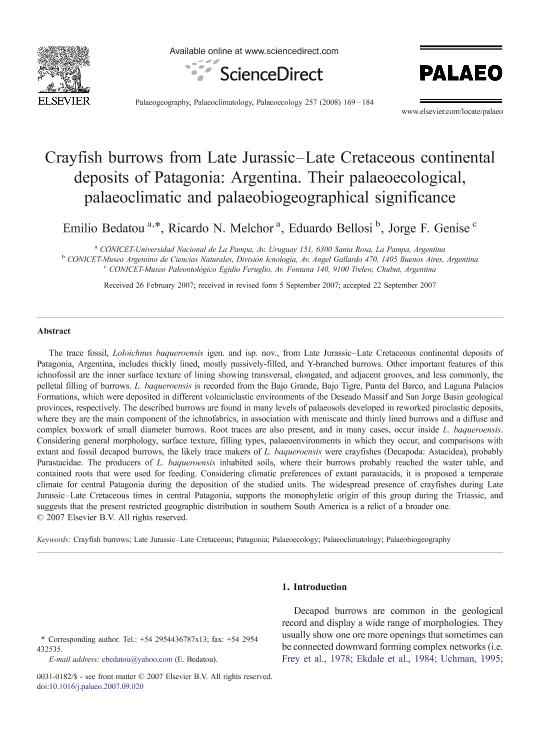Mostrar el registro sencillo del ítem
dc.contributor.author
Bedatou, Emilio

dc.contributor.author
Melchor, Ricardo Nestor

dc.contributor.author
Bellosi, Eduardo Sergio

dc.contributor.author
Genise, Jorge Fernando

dc.date.available
2019-08-14T22:18:32Z
dc.date.issued
2008-01
dc.identifier.citation
Bedatou, Emilio; Melchor, Ricardo Nestor; Bellosi, Eduardo Sergio; Genise, Jorge Fernando; Crayfish burrows from Late Jurassic-Late Cretaceous continental deposits of Patagonia: Argentina. Their palaeoecological, palaeoclimatic and palaeobiogeographical significance; Elsevier Science; Palaeogeography, Palaeoclimatology, Palaeoecology; 257; 1-2; 1-2008; 169-184
dc.identifier.issn
0031-0182
dc.identifier.uri
http://hdl.handle.net/11336/81631
dc.description.abstract
The trace fossil, Loloichnus baqueroensis igen. and isp. nov., from Late Jurassic-Late Cretaceous continental deposits of Patagonia, Argentina, includes thickly lined, mostly passively-filled, and Y-branched burrows. Other important features of this ichnofossil are the inner surface texture of lining showing transversal, elongated, and adjacent grooves, and less commonly, the pelletal filling of burrows. L. baqueroensis is recorded from the Bajo Grande, Bajo Tigre, Punta del Barco, and Laguna Palacios Formations, which were deposited in different volcaniclastic environments of the Deseado Massif and San Jorge Basin geological provinces, respectively. The described burrows are found in many levels of palaeosols developed in reworked piroclastic deposits, where they are the main component of the ichnofabrics, in association with meniscate and thinly lined burrows and a diffuse and complex boxwork of small diameter burrows. Root traces are also present, and in many cases, occur inside L. baqueroensis. Considering general morphology, surface texture, filling types, palaeoenvironments in which they occur, and comparisons with extant and fossil decapod burrows, the likely trace makers of L. baqueroensis were crayfishes (Decapoda: Astacidea), probably Parastacidae. The producers of L. baqueroensis inhabited soils, where their burrows probably reached the water table, and contained roots that were used for feeding. Considering climatic preferences of extant parastacids, it is proposed a temperate climate for central Patagonia during the deposition of the studied units. The widespread presence of crayfishes during Late Jurassic-Late Cretaceous times in central Patagonia, supports the monophyletic origin of this group during the Triassic, and suggests that the present restricted geographic distribution in southern South America is a relict of a broader one.
dc.format
application/pdf
dc.language.iso
eng
dc.publisher
Elsevier Science

dc.rights
info:eu-repo/semantics/openAccess
dc.rights.uri
https://creativecommons.org/licenses/by-nc-sa/2.5/ar/
dc.subject
Crayfish Burrows
dc.subject
Late Jurassic-Late Cretaceous
dc.subject
Palaeobiogeography
dc.subject
Palaeoclimatology
dc.subject
Palaeoecology
dc.subject
Patagonia
dc.subject.classification
Paleontología

dc.subject.classification
Ciencias de la Tierra y relacionadas con el Medio Ambiente

dc.subject.classification
CIENCIAS NATURALES Y EXACTAS

dc.title
Crayfish burrows from Late Jurassic-Late Cretaceous continental deposits of Patagonia: Argentina. Their palaeoecological, palaeoclimatic and palaeobiogeographical significance
dc.type
info:eu-repo/semantics/article
dc.type
info:ar-repo/semantics/artículo
dc.type
info:eu-repo/semantics/publishedVersion
dc.date.updated
2019-08-14T20:07:46Z
dc.journal.volume
257
dc.journal.number
1-2
dc.journal.pagination
169-184
dc.journal.pais
Países Bajos

dc.journal.ciudad
Amsterdam
dc.description.fil
Fil: Bedatou, Emilio. Consejo Nacional de Investigaciones Científicas y Técnicas. Instituto de Ciencias de la Tierra y Ambientales de La Pampa. Universidad Nacional de La Pampa. Facultad de Ciencias Exactas y Naturales. Instituto de Ciencias de la Tierra y Ambientales de La Pampa; Argentina
dc.description.fil
Fil: Melchor, Ricardo Nestor. Consejo Nacional de Investigaciones Científicas y Técnicas. Instituto de Ciencias de la Tierra y Ambientales de La Pampa. Universidad Nacional de La Pampa. Facultad de Ciencias Exactas y Naturales. Instituto de Ciencias de la Tierra y Ambientales de La Pampa; Argentina
dc.description.fil
Fil: Bellosi, Eduardo Sergio. Consejo Nacional de Investigaciones Científicas y Técnicas. Oficina de Coordinación Administrativa Parque Centenario. Museo Argentino de Ciencias Naturales “Bernardino Rivadavia”; Argentina
dc.description.fil
Fil: Genise, Jorge Fernando. Consejo Nacional de Investigaciones Científicas y Técnicas; Argentina. Museo Paleontológico Egidio Feruglio; Argentina
dc.journal.title
Palaeogeography, Palaeoclimatology, Palaeoecology

dc.relation.alternativeid
info:eu-repo/semantics/altIdentifier/url/https://www.sciencedirect.com/science/article/pii/S0031018207005007
dc.relation.alternativeid
info:eu-repo/semantics/altIdentifier/doi/https://doi.org/10.1016/j.palaeo.2007.09.020
Archivos asociados
